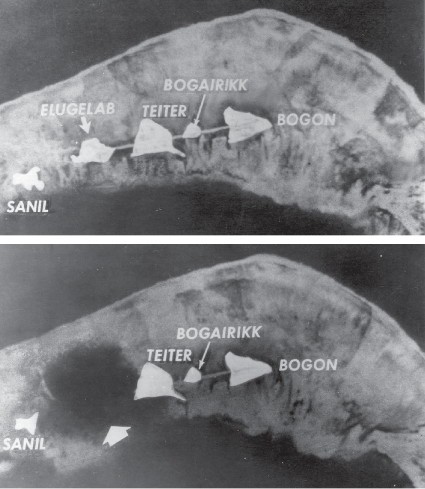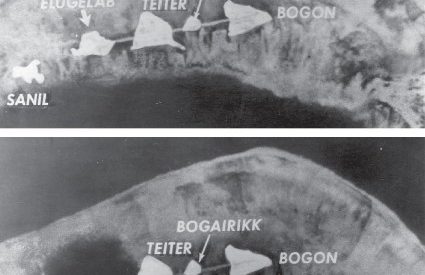?? By its very nature it cannot be confined to a military objective but becomes a weapon which in practical effect is almost one of genocide ??
– Enrico Fermi and I.I. Rabi in an addendum to the GAC?s report on the hydrogen bomb, c. 1951
In June, 1954, Winston Churchill sat in the red room of the White House with Secretary of State John Foster Dulles and President Dwight Eisenhower and watched a film called ?Project Ivy? on the president?s television. Later, he returned to London and regretfully ordered all work on air raid and fallout shelters abandoned.
He knew they would be of little use after the horror of what he just saw.
Four years earlier, President Harry Truman made the decision to pursue the development of thermonuclear (hydrogen) weapons ? a new type of destructive ?superbomb? that differed substantially from the conventional atomic weapons being tested in that it was powered not just by fission (breaking an atom into two pieces), but also the fusion of hydrogen atoms to form a third atom.
While significant amounts of energy are released with an atomic bomb, the hydrogen bomb releases significantly more energy, resulting in a much more devastating blast ? up to 100 times more devastating.
Despite his seeming distaste with nuclear weapon development, after his election, Dwight Eisenhower made nuclear weapons the centerpiece of his strategic defense policy. Just prior to his election, during Truman?s second term, ?international communism? was making great strides toward its professed goal of world domination. The Soviet Union demonstrated its first atomic bomb; China fell to Mao Zedong and the Communist insurgency, and the Korean War seemed mired to a standstill. Truman had responded with a bold military expansion program, taking the recommendations of National Security Council Paper Number 68 commissioned as part of his January 1950 decision to go full speed ahead with the development of the hydrogen bomb ? a weapon that Eisenhower and Dulles perceived as a ?deterrent of massive retaliatory power ? to deter aggression.?
It was an implication that the United States would these massive bombs, at a time and location of its choosing, as a response to any military challenge.
Little was known of the full-scale effects of nuclear power, so from 1950 to 1953 the U.S. embarked on numerous above- and underground tests of weapons, both in the South Pacific and in the Nevada desert, with various destructive yields ranging from 1-kiloton to 61-kilotons.
While President, Truman avoided deliberate threats to use nuclear weapons, as the limited number of available warheads may have been insufficient to ward off a full-scale attack by the Soviet Union. But by 1952 that situation changed. Atomic bombs were getting cheaper to produce and worse, Soviet technology was catching up.
Especially wary of the Soviet advances, in June 1952, the Joint Chiefs of Staff informed the Atomic Energy Commission that the situation with the Soviet Union made necessary the production by 1954 of a megaton-range thermonuclear weapon that would be compatible with current delivery systems.
But the AEC was ahead of the curve. As early as June 1951, their General Advisory Committee, headed by Robert Oppenheimer, met at Princeton with the Los Alamos scientists to discuss the future of nuclear weapons research. The group was unanimously in favor of rapid pursuit of a thermonuclear weapon ?with a test to be prepared as soon as it was clear what exactly was to be tested.? Los Alamos suggested moving directly to the testing of a full-scale experimental device, and in September proposed conducting that test at Enewetak atoll in the South Pacific in November, 1952.
The Ivy series
This became the two-shot ?Ivy? series of nuclear testing. Mike, the larger thermonuclear (hydrogen) bomb, was to be detonated first, followed two weeks later by King, the largest fission (atomic) device ever tested, with a yield of 500 kilotons.
Ivy Mike was estimated to be about 6-megatons but no one was really sure just how powerful it really was, as everyone was working in uncharted waters. Physically, it was a gigantic weapon, standing 20 feet tall, about seven feet in diameter. The assembly was contained in a steel casing 80 inches wide and 244 inches long, with walls 12? thick, making it America?s largest single forging up to that time. The insane device weighed about 82 tons.
Fears abounded as to the destructive potential of such a weapon ? some scientists actually were concerned the awesome fireball would ignite the atmosphere and wrap the earth in a similar blazing Armageddon that killed the dinosaurs eons earlier. Other scientists discounted that theory. The stakes were too high ? no one was willing to err on the side of caution.
Ivy Mike?s ground-zero was a six-story open air steel-frame structure on the small island of Elugelab on the north end of the atoll. Mike used a fission-fusion concept where radiation from a primary fission device was used to implode a liquid-deuterium secondary, producing the fusion reaction.
With the atoll cleared of any people, and observers located at presumed safe distances from 25 to 35 miles away, at 7:15 a.m. on November 1, 1952, Ivy Mike was detonated.
Four days after the detonation, Dwight D. Eisenhower was elected President of the United States. A week later, Roy Snapp, secretary of the AEC and armed with a concealed pistol, carried a top-secret document from Chairman Gordon E. Dean to the president-elect at the Augusta National Golf Club in Georgia. The cover letter from Dean relayed information of such importance that President Truman had asked Dean to convey the news at once to Eisenhower.
?The significant event to date,? Dean wrote, ?is that we have detonated the first full-scale thermonuclear device.?
Snapp then sheepishly informed the President-elect that the island of Elugelab was now missing.
Erased off the map
The full fury of Ivy Mike had been woefully underestimated. It clocked in at a whopping 10.5-megatons ? over 700 times the size of the Hiroshima detonation ? rather than the 6-megatons projected. It had produced a 150-million-degree fireball ?many times the strength of the sun? three miles in diameter, with a heat wave measuring 180 degrees instantly slamming the observers, with one reporting as ?like a hot iron.?
Within two minutes of the wind and deafening roar of the detonation, the mushroom cloud boiled to 40,000 feet (almost 8 miles). Ten minutes later, the cloud stem had pushed upward about 25 miles into the stratosphere. The mushroom portion spread for an astonishing 100 miles across.
?You would swear,? one awestruck navy observer later stated, ?that the whole world was on fire.?
?Something I will never forget was the heat,? recalled Harold Agnew from a ship over 25 miles away from the blast. ?Not the blast ? the heat just kept coming, just kept coming on and on. It?s really quite a terrifying experience because the heat doesn?t go off ? on kiloton shots it?s a flash and it?s over, but on those big shots it?s really terrifying.?
Agnew went on to suggest that every five years all world leaders should witness a multi-megaton shot such as Ivy Mike. ?It would really put the fear of Allah, or God, or Mohammed, or Buddha, or somebody, in their veins. It?s really quite a terrifying experience.?
What was most terrifying to many of the scientists ? possibly even more than the jaw-dropping fireball ? was that the gargantuan blast had obliterated Elugelab. The island had disappeared, and in its place was an undersea crater almost two miles in diameter and 17 stories deep.
Seventeen stories deep.
In addition to wiping the island off the map, nearby islands such as Engebi and Rigili were almost completely stripped of vegetation. Only stumps remained three miles to the east on Engebi. Fish carcasses had skin burned and missing from only one side as if they had been dropped in a hot pan. On Rigili, fourteen miles to the southwest from ground zero, ?trees and brush facing the test site had been scorched and wilted by the thermonuclear heat.? A few birds found on the islands ?were sick, grounded ? and reluctant to fly.?
 High-altitude imagery showing the disappearance of Elugelab after the detonation of Ivy Mike.
High-altitude imagery showing the disappearance of Elugelab after the detonation of Ivy Mike.
Remarkably, scientists were not thumping their chests and high-fiving at America?s bold first step into a thermonuclear era ? in fact, most were actually stunned at what they had unleashed and witnessed. Many expressed regret at their accomplishment. Herbert F. York, who was the first director of the new weapons laboratory at Livermore, California, wrote of a ?foreboding? when he thinks of Ivy Mike. According to him, the test ?marked a real change in history ? a moment when the course of the world suddenly shifted, from the path it had been on to a more dangerous one. Fission [atomic] bombs, destructive as they might have been, were thought of being limited in power. Now, it seemed, we had learned how to brush even these limits aside and to build bombs whose power was boundless.?
When the full awesome power of Ivy Mike was relayed to President-elect Eisenhower that day at Augusta, Georgia, he also expressed regret at the rapid development of bigger and more powerful nuclear weapons, stating that there was no need ?for us to build enough destructive power to destroy everything.?
?Complete destruction,? he added, ?was the negation of peace.?
But the Russian tests of Joe 1?4 changed his mind, and the arms race was on.
Ivy Mike was not America?s biggest nuclear test ? that honor goes to Castle Bravo, a 15-megaton monster unleashed on March 1, 1954 that turned out to be 2?1/2 times bigger than anticipated. It poisoned the Pacific atmosphere and almost killed all the people who developed it. But Mike was the first to usher in a new generation of, as Enrico Fermi called it, destructive genocide.
###
Read more at www.dalebrumfield.net. My new novel ?Naked Savages? now available everywhere.


